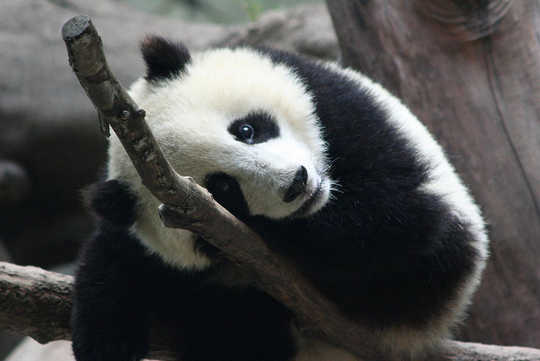
Cute, yes, but what about the African water rat? Will Sowards/flickr, CC BY
What would you like to study next year? The Bengal tiger, or the African water rat? It is an important question, for rarely, it seems, is there an impetus to study species that are highly successful, numerous or considered “ordinary”. This continued momentum towards the weird, wonderful and endangered can frequently be driven by the fact that endangered and exotic species attract funding, high journal impact and equally importantly, publicity. “Ordinary”, “less cute” species do not.
From the perspective of species conservation and biodiversity, there has been much discussion about the prevalence of prioritising large, highly-visible and aesthetically pleasing species over smaller, more everyday animals. Habitat conservation typically does benefit all species which live within a preserved area, and so flagship animals, which are often used to front campaigns and high-profile research projects, do help support other species by attracting public support – and money – to the cause. But scientists must be careful not to overlook our planet’s other, less “glamorous” creatures. They are vital to our understanding of biology.
With finite time, money and resources, preference currently is given to those species in critical danger of persecution or immediate need of protection: pandas, tigers, rhinos. But the impact of this on our knowledge of animal biology – their physiology, energetics, ecology and behaviour – is not yet fully understood. A scientific study on the physiology of the African elephant (Loxodonta Africana), for example, is unlikely to inform greatly on that of the African water rat (Dasymys incomtus) despite the fact that they frequently share the same habitat.
Indeed, there is a chance that our focus on these exotic and endangered species is biasing our knowledge of animal biology. A recent review revealed that 42% of studies published in the selected journals focused on species listed as threatened. Conversely, only 4% involved research into those categorised as non-threatened.
This means that we tend to study those animals that are struggling to adapt and modify under the pressures of human activity worldwide. And as a consequence, we spend less time discovering how more common and “successful” species are seemingly able to adapt and change to these pressures, and the mechanisms, characteristics and traits that enable them to do so.
Where should we be looking?
Phenotypic plasticity, the ability of an organism to change its observable traits in response to changes in the environment, has received much deserved attention in recent years, particularly in birds.
It has been suggested that these species may well cope better with climate and habitat change. Early studies on phenotypic plasticity have, as perhaps a logical starting point, focused on nature’s extremists and athletes, in line with the fascination for studying exotic and endangered species.
Examples include long distance migratory shore birds, such as godwits, groups of which can migrate up to 11,000km over the open ocean without stopping. That these species are able to undertake such extensive and impressive migrations suggests a natural predisposition for plasticity of the body’s organs throughout the annual cycle, enabling them to cope with such energetically challenging and demanding events. Indeed, these species show much propensity for change in their digestive organs, muscles and fat stores.
Other species have shown very rapid changes in their migratory habits and routes. Classic examples, which have attracted considerable attention, are blackcaps (Sylvia atricapilla) and chiffchaffs (Phylloscopus collybita) – both passerine birds which have, over the last 50 years, gradually begun moving from central Europe to overwinter in the UK, halting their migration post-breeding to sub-Saharan Africa, some 7,000km away. Why these unusual species would show this trait while other similarly-sized, closely-related birds with similar diets don’t is not fully understood. More work is needed on less “extraordinary” birds.
Currently, the extent of this flexibility and what initiates such changes is unclear. Of course plasticity can only go so far in response to change. For example, metabolic rate cannot increase or decrease indefinitely, and at some juncture, anatomical factors will impose a limit on what degree of change is possible. This plasticity, however, has not been tested extensively in what one might consider a more “typical” or “ordinary” species, and particularly not in their natural environment.
Looking ahead
It is possible that these “normal” species are capable of demonstrating equally admirable plasticity in their characteristics, but the environmental scenario which requires its exhibition has not yet arisen.
Evolutionary ecologist Massimo Pigliucci has suggested a potential reason why there are few studies on this: “This field often relies on studies that are low-tech and tedious to carry out, and yet demanding high personnel costs and long periods of time, a combination that is sometimes difficult to justify to funding agencies when compared with more ‘high-tech’ science.” Understanding the potential and capacity for change in particular species is vital for predicting the responses of different species to anticipated changes in the climate and general landscape.
A firm basis for understanding the capacity of a species to change can only come from a sound platform of good general knowledge of animal biology, in particular from those species which are numerous, prosperous, and operate successfully within a changing environment. Of course, important and vital research must continue into endangered species, but a longer and larger-scale outlook is critical if we are to recognise fully the extent of change that may take place in response to shifts in the climate. “Ordinary” should no longer be a dirty word when it comes to what is recognised and endorsed by funders and researchers.
About the Author
This article originally appeared on The Conversation
Related Books
at InnerSelf Market and Amazon

























